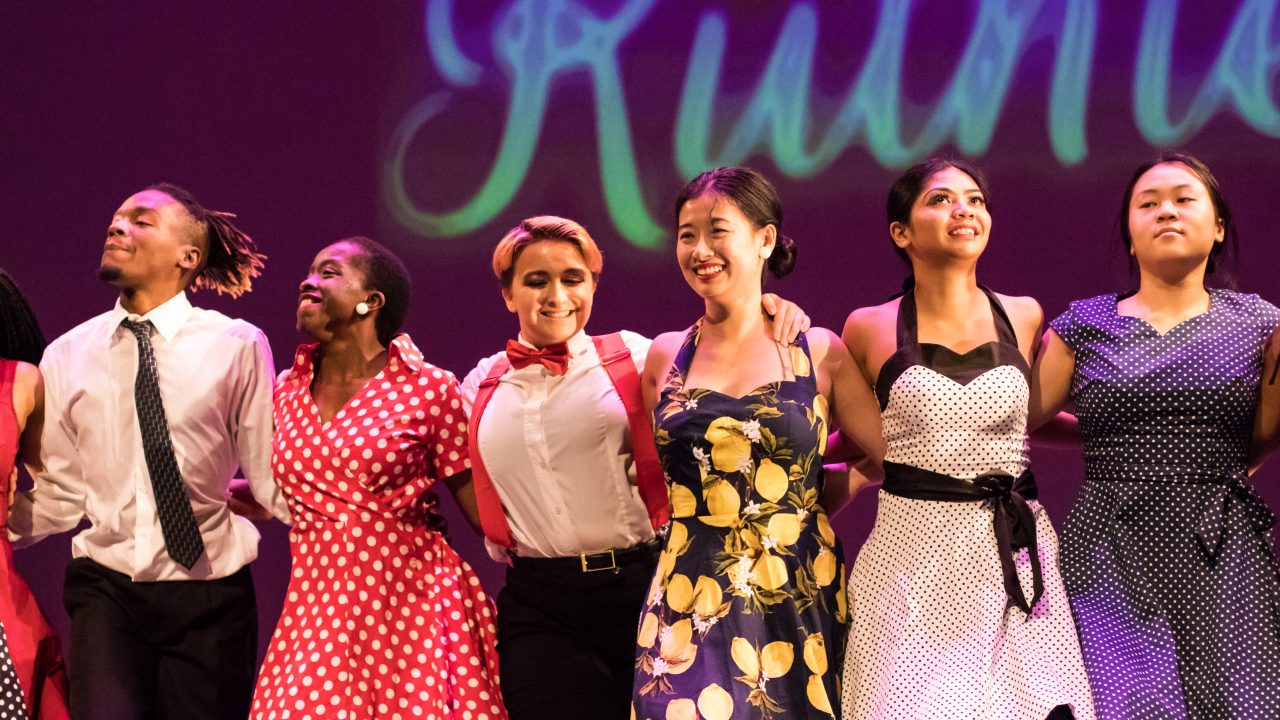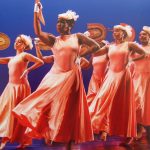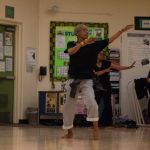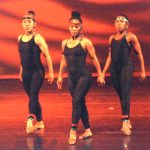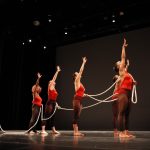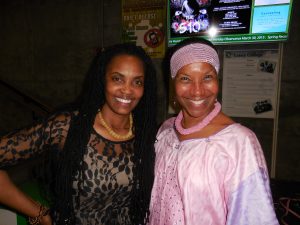WHAT IS DANCE PRODUCTION?
When the audience takes their seats in a theatre and the lights go down, a magical hush fills the air. The curtain goes up, the lights display splashes of color and the dance begins. The audience, concerned only with what is happening on stage in the present, rarely thinks about the long process that has brought the dancers to this moment. It would be surprising for some to realize exactly how much work and energy goes into mounting a dance production. An incredible amount of work has to be done in addition to creating the choreography and holding rehearsals.
Dance Production is and always has been a collaborative effort. Being among and working with many people who assume a wide variety of roles, titles and responsibilities. The task of planning and organizing a dance concert is an overwhelming and sometimes exhausting undertaking. Therefore, it is crucial to have a well thought-out plan of action and adhere to the timing and schedule of that plan. Every production is unique. There is constant overlap and combining between areas of responsibility that are worked out from show to show. What worked in a previous show, may not work in the current show. As a student, choreographer or performer, you need not know how to do all the numerous jobs associated with the producing of a dance concert, but you should know who does what. Example, if a stage light burns out, you would know who to tell or if you needed a table and chair in your dance, you would know who to ask for it. Most dance productions engage the following personnel:
- Artistic Director, over sees entire production and is responsible for the overall aesthetic and artistic vision of the production and makes all final decisions relative to all artistic issues. One of the many responsibilities of the artistic director is to choreograph for the production and/or invite guest choreographers to create dances that will be performed. Once it is determined which dances will appear/perform, the artistic director programs the dances so that they are performed in an appropriate concert order.
- Stage Manager, runs all rehearsals – tech & dress, assigns dressing rooms, in charge of sign-in, is basically responsible for everything that happens backstage. The stage manager is also responsible for ‘calling the show’; giving directions for the sound and lighting cues. The stage manager’s ability is crucial to the overall success of the performance and usually has an assistant to help with the details.
- House Manager, is responsible for and runs everything in the front of the house, including tickets/booth, all ushers and vendors.
- Lighting Director runs the show from a light board/booth and is in charge of all lights on stage, in the house and follow spot. The Lighting Designer transforms the stage space and helps choreographers ‘say’ what they want by making sure all lighting instruments are strategically placed on the stage. Theatrical light, which is entirely unnatural, fosters sight and insight; it is a subliminal whisper providing emphasis telling us what to make of what we see. Light provides a theatrical feel to the dance that most choreographers desire.
- Technical Director, is in charge of all equipment, instruments backstage and technical aspects of the performance, including hanging lights and building any sets. The technical director usually has a ‘tech/stage crew for assistance.
- Audio Engineer, is in charge of all sound equipment and projections.
- Artistic Collaborators are; costume designer & construction, seamstress, hair & make-up artist, scenic designer, musical director, composer(s) live accompanist, prop master/coordinator, in charge of building, moving and storing. A successful dance concert invariably leaves the audience with the feeling of having had a significant experience, whether emotionally moving, visually stimulating, kinesthetically exciting or simply clever and entertaining. That’s what this class will attempt to do! Nevertheless, there are some factors, apart from those universe rally cited concerning excellence of choreography and its execution that can be isolated and profitably discussed. These are the mundane problems that invariable confront anyone trying to encourage more effective dance performances. Who should perform and who should choreograph? One of the most difficult problems encountered involves the question of how to select dancers and choreographers for a performance. The dilemma. Given the many pressures to perform that is exerted by today’s young dancers, it is common and in fact, inevitable that this process will raise conflicting feelings in students trying to uphold the standards of their art without ceasing to respect the aspirations of their student peers. There are of course, what we call “natural” performers. These are the performers that draw our eyes immediately upon the opening of the curtain or the beginning of the dance, regardless of how little training or experience they may have had previously. But for most, performance is something that is learned, and part of that lesson is learned from onstage experience. Without an opportunity to perform, this ability may not be completely developed. Likewise, if a choreography is not shown to an audience, its strengths and weaknesses will never be fully illuminated. Given the primary need and desire of high artistic standards for works presented to an audience, the importance of paying careful attention to the creative and technical level of the performers and choreographers cannot be overestimated. There are various types of productions. For example, Workshop, implies immediately that the production to be viewed is going to be offered on a relatively modest scale. Demonstration, is a term commonly used to designate an informal showing of works. There are other terms that may be used to denote steps before the final category of Concert. This class will produce a Dance Concert.
- The time of performance can be varied effectively with results appropriate to different levels of proficiency. An evening performance is always more formal than a noon or afternoon showing of dance works and evening audiences can be expected to be more demanding. That is not to say that because one performs a matinee, one gives less than 100%, on the contrary, one gives 200% to the matinee audience!
- Costumes and lighting are crucial to any work of dance. Choreographers must consider the effects of costumes and lighting. Elaborate costumes in a two minute work composed of simple ‘step-together-step-touch’ patterns may mislead the audience into expecting a work of a more substantial nature. Whereas the use of basic leotards and tights might be much more effective… and maybe an imaginative use of color can be brought into play to distinguish the roles of dancers or divide the stage space. Choreographers must also consider the effects of lighting. Complicated light plots often times over power a dance or perhaps do little more than to emphasize the defects in a piece that is itself simple in its realization.
- Scaling your choreography. It is common and natural for less experienced dance students to undertake unrealistic choreographic themes or projects beyond their technical level and the maturity of their life experience. The most common undertaking seems to be the preference for grandiose dance themes that stand little chance of being developed successfully into a coherent dance. It’s okay to develop and create from simple. Less ambitious material or themes can be choreographed very effectively by less experienced students and is just as impressive in performance. Psychologically subtle and metaphysical themes are best left for the more experienced choreographer. With that said, if the movements themselves are technically beyond the performing capability of the dancers, the effect will only magnify the limitations of each performer… unnecessarily.
- The designation of a performing area or stage can be made anywhere. While the possibilities for defining the stage area are virtually endless, this class is limited to the studio and the small or little theater. (seats less than 450)
- There is an artistic challenge and responsibility for everyone involved that must be met if the dance production performance is to be successful. The success of the production is in your hands, are you ready?
- Dance is perhaps the most hedonistic of the arts simply because of the fact that movement in itself is a pleasurable experience. The more one becomes aware of and sensitive to, the sensuous feedback of moving, the more one can become absorbed in the self. Here lies a danger for both the choreographer and dancer. The selective eye needs to be always on guard to ensure that the joys of movement are not limited to the experiences of the participants themselves but can be transmitted to an audience, which has given up both time and money to sit in attendance. The inability or unwillingness to communicate movement in a medium that by its very definition is a performing art only serves to alienate the audience and thereby nullifying the power of dance.
- The choreographers attitude toward the audience is every bit as important, if not more so, as the dancers attitude toward performance! Dance is a performing art and as such requires the physical presence of an audience at a certain time and a specific place. A performance is conceived with the idea of its being presented to someone. This thought should not be lost sight of in the course of preparing for the production. It is especially easy for those absorbed in their work to confuse the expression of the art form with what is little more than ego indulgence.
- Your attitude toward performance is extremely important. It is vital that everyone knows from the outset the importance of working with their full concentration, commitment, honesty and integrity toward the performance. At rehearsal, your attitude and goal must be, the performance! Always, dance like no one is watching. To instill this attitude is not an easy task. The weeks and months of intensive rehearsals needed to prepare a work for the stage can and will be exhausting… excruciatingly so! The practice that leads to the more perfect execution of movement too often becomes an exercise in rote mechanical action. This is what fosters and perpetuates the ridiculously ‘naïve’ attitude that… “I won’t do that when I’m on stage or the audience is present” your spontaneity and inspiration to dance will return. That’s not going to happen… 99.9% , you will perform just as you rehearsed. This refrain betrays a false sense of security and is a dangerous assumption. There is no question that the presence of an audience affect performers. The excitement generated raises the adrenaline level of the body and a heightened awareness results that makes the performer more alert and more sensitive than in rehearsal. But that same excitement can be the thing that destroys your performance. For example, tension never seen previously during rehearsals suddenly becomes evident in the neck and limbs of your body… Balance, apparently secure in the studio rehearsal is destroyed because of nervousness. Other less subtle changes may be detected in your face. By constantly stressing an ‘attitude of performance’ during the sometimes grueling days of rehearsal makes the transference from the rehearsal studio to the stage more natural and a much better performance.
- The little theater or theatre also provides an intimate performance area. However, the fact of having an actual stage, installed lights and other accoutrements of the theatre brings higher expectations and greater formality than that of the studio. This is natural and desirable. There is a special separation between the audience and performers that that is not only literally existent, but also psychologically. It’s here that the performers must try to bridge the gap. Still, because of the size of the theatre and the distance from performer to audience, the intensity required for projection is not overly demanding or uncomfortable. Now the large theatre that seats 500 plus patrons is a different situation altogether!
- The studio is the least pretentious setting for a dance performance and has the advantage of providing very close contact with the audience. Generally this setting gives members of the audience a special feeling of goodwill toward the performers; perhaps the close proximity of the two heightens audience responsiveness. This atmosphere is especially important for less experienced dance students. Dancers in such a situation can learn a great deal about projection. A difficulty with performing that close to an audience is that the performer may lose concentration due to the distraction of seeing a particular face in the seats. The almost instinctive urge to acknowledge or to ignore that person threatens the concentration necessary for performance. Constant practice will enable the dancer to see the audience, yet not be distracted… To project beyond the personal through the movement. The studio is an excellent place to present ‘first’ works… informal showings, works in progress and previews of completed dances. The formality is constructive and also conducive to the staging of experimental works and other types of dances that in their very conception demand intimacy to succeed. Often disarming in its simplicity, the studio performance generates a wonderful atmosphere.


